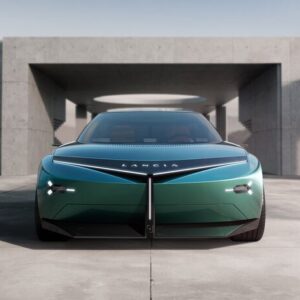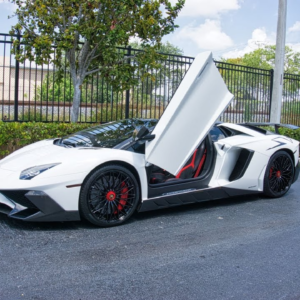
The Chevrolet Corvette Z06 won our Performance Car of the Year award for 2023 thanks to its absolute performance at an amazing price. What if Chevrolet took this chassis and prepped it for the 2024 24 Hours of Daytona? It just to happens that IMSA rule changes mean the Corvette Z06s you’ll see racing at Daytona next year will have far more in common with your street car than they do right now.
The rule changes coming to GTD Pro are hinted at in the race car’s name. The category is aligning to the FIAs GT3 ruleset which should open competition to any team and manufacturer with a GT3-ready car. We’ve already seen the impact this has made with the standard GTD class with teams racing cars from BMW, Ferrari, Lexus, AMG, and more. The older GTLM class had dwindled to just two cars: Corvette Racing and its C8.R, and Proton Competition’s Porsche 911 RSR. In order for Corvette Racing to use the C8.R this year, it had to be converted from GTLM specification to GTD Pro, and the chassis is still exclusive to Corvette Racing.
However, with the new Z06 dropping to the masses, what better way to promote it than to take a chassis off the Bowling Green line and make it into a GT3-specification race car? The engine the Z06 uses was developed from the engine in the C8.R, why not go all the way? That’s what GM is doing with the GT3.R. Even better, the race car chassis is no longer exclusive to Corvette Racing; GM will build customer cars for interested race teams.
How To Build A Z06 GT3.R

Once a Z06 chassis is selected from the assembly line, it gets pulled and sent to Pratt Miller for its final racing assembly. Since the Corvette is made using aluminum, the steel roll cage is welded to a special base plate that is secured to the chassis. Additionally, other safety improvements pioneered on the C7.R and developed through to the C8.R include the side-impact structure between the driver’s door and the FIA mandated roll cage. Whenever you’ve seen the C8.R make a pit stop and you’ve seen a bright yellow box appear when the door is opened, that is the crash structure they are talking about.
While the double-wishbone suspension is track ready, a set made by Pratt Miller is far more adjustable and fits a set of 18×12.5 front and 18×13 inch wheels that are currently used on the C8.R. For IMSA racing, it will also be fitted with a set of Michelin S9M tires. Otherwise, the suspension design is the same as is used on the street-going Z06. This added adjustability also allows for the GT3.R to be used by any series that allows FIA GT3 cars to enter and for its customers to be able to adjust for different tires specifications, balance-of-performance requirements, and driver preference. The aerodynamics are also further tweaked for stability, but are adjustable while also improving engine cooling for endurance racing.
However, the part of the production Z06 that remains on the GT3.R is the LT6, as it was directly developed as part of the C8.R program. It’s even built on the same production line as the road-going LT6 and more than 70 percent of the street engine is used on the race engine. The major components that are the same between race car and street car are the flat plane crankshaft, connecting rods, cylinder heads, fuel injectors, ignition coils, and gaskets. Everything else is racing-optimized, like additional sensors, exhaust, and the like.
Racing Requires Support
While Chevrolet won’t be offering a factory pit crew, a Corvette Z06 GT3.R owner won’t be left totally alone. Like many manufacturers that have a GT3 production program, GM will offer customer support for things like spare body panels and internal components. This will even include a full support parts truck that will travel to North American race events in 2024. This will expand to overseas customers as the program ramps up within the first two years of the GT3.R program, according to GM. There will also be technical support for GT3.R customer teams for full engineering, race strategy and other incremental support options as well as remote engineering and operations support when Corvette Racing can’t be there directly.
Development Started Without Anyone Actually In It

The development of the Z06 GT3.R didn’t begin on a real track. It started with virtual simulation using Chevrolet’s “Driver in the Loop” program in 2021. It didn’t actually hit the track until September of 2022, but Chevrolet promises that the GT3.R will have a full year of real world development as it’s set to become available to those interested by the third quarter of this year—just in time for those customers to start testing and developing their programs for the 2024 Daytona 24 Hours or other series they happen to take part in. This will also build off the modified C8.R GTD program that ends after the end of the 2023 season, we imagine.
Currently, supported race series include the IMSA WeatherTech SportsCar Championship, the FIA WEC (with two GT3.R chassis as a double entry, including the 24 Hours of Le Mans), and Chevrolet is looking into supporting the SRO America and the SRO International GT Challenge. Specific teams have yet to be announced for the GT3.R customer programs, and no price has been announced to purchase a race-ready Corvette Z06 GT3.R.
However, with the new Z06 dropping to the masses, what better way to promote it than to take a chassis off the Bowling Green line and make it into a GT3-specification race car? The engine the Z06 uses was developed from the engine in the C8.R, why not go all the way? That’s what GM is doing with the GT3.R. Even better, the race car chassis is no longer exclusive to Corvette Racing; GM will build customer cars for interested race teams.
How To Build A Z06 GT3.R

Once a Z06 chassis is selected from the assembly line, it gets pulled and sent to Pratt Miller for its final racing assembly. Since the Corvette is made using aluminum, the steel roll cage is welded to a special base plate that is secured to the chassis. Additionally, other safety improvements pioneered on the C7.R and developed through to the C8.R include the side-impact structure between the driver’s door and the FIA mandated roll cage. Whenever you’ve seen the C8.R make a pit stop and you’ve seen a bright yellow box appear when the door is opened, that is the crash structure they are talking about.
While the double-wishbone suspension is track ready, a set made by Pratt Miller is far more adjustable and fits a set of 18×12.5 front and 18×13 inch wheels that are currently used on the C8.R. For IMSA racing, it will also be fitted with a set of Michelin S9M tires. Otherwise, the suspension design is the same as is used on the street-going Z06. This added adjustability also allows for the GT3.R to be used by any series that allows FIA GT3 cars to enter and for its customers to be able to adjust for different tires specifications, balance-of-performance requirements, and driver preference. The aerodynamics are also further tweaked for stability, but are adjustable while also improving engine cooling for endurance racing.
However, the part of the production Z06 that remains on the GT3.R is the LT6, as it was directly developed as part of the C8.R program. It’s even built on the same production line as the road-going LT6 and more than 70 percent of the street engine is used on the race engine. The major components that are the same between race car and street car are the flat plane crankshaft, connecting rods, cylinder heads, fuel injectors, ignition coils, and gaskets. Everything else is racing-optimized, like additional sensors, exhaust, and the like.
Racing Requires Support
While Chevrolet won’t be offering a factory pit crew, a Corvette Z06 GT3.R owner won’t be left totally alone. Like many manufacturers that have a GT3 production program, GM will offer customer support for things like spare body panels and internal components. This will even include a full support parts truck that will travel to North American race events in 2024. This will expand to overseas customers as the program ramps up within the first two years of the GT3.R program, according to GM. There will also be technical support for GT3.R customer teams for full engineering, race strategy and other incremental support options as well as remote engineering and operations support when Corvette Racing can’t be there directly.
Development Started Without Anyone Actually In It

The development of the Z06 GT3.R didn’t begin on a real track. It started with virtual simulation using Chevrolet’s “Driver in the Loop” program in 2021. It didn’t actually hit the track until September of 2022, but Chevrolet promises that the GT3.R will have a full year of real world development as it’s set to become available to those interested by the third quarter of this year—just in time for those customers to start testing and developing their programs for the 2024 Daytona 24 Hours or other series they happen to take part in. This will also build off the modified C8.R GTD program that ends after the end of the 2023 season, we imagine.
Currently, supported race series include the IMSA WeatherTech SportsCar Championship, the FIA WEC (with two GT3.R chassis as a double entry, including the 24 Hours of Le Mans), and Chevrolet is looking into supporting the SRO America and the SRO International GT Challenge. Specific teams have yet to be announced for the GT3.R customer programs, and no price has been announced to purchase a race-ready Corvette Z06 GT3.R.
































